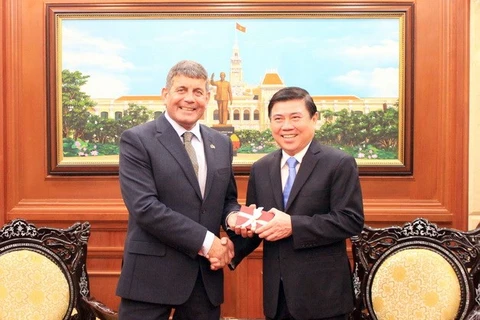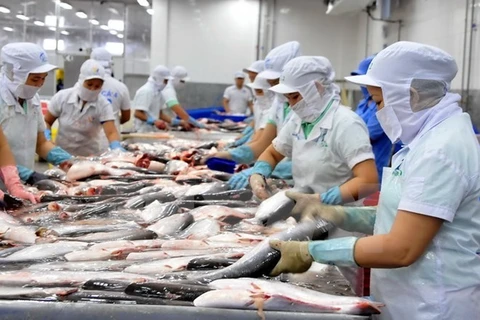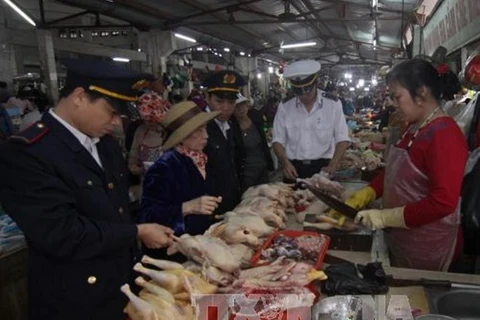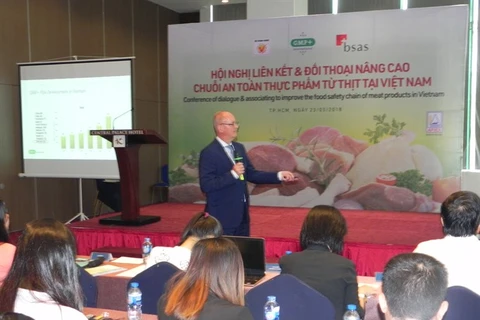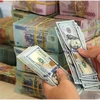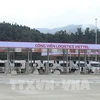 Herb Cochran, senior director of Trade Facilitation and Special Projects of AmCham Vietnam in HCM City, speaks with media on the sidelines of a seminar on food safety regulations (Source: VNA)
Herb Cochran, senior director of Trade Facilitation and Special Projects of AmCham Vietnam in HCM City, speaks with media on the sidelines of a seminar on food safety regulations (Source: VNA)HCM City (VNA) - Vietnamese enterprises should strive to meet strict food safety requirements from importing countries, especially choosy markets like the US, Japan, the Republic of Korea, and the European Union (EU), participants said at an international seminar held in Ho Chi Minh City on April 3.
It is now time to comply with new regulations as food-safety regulation non-compliance is the largest barrier to entry for Vietnamese firms, said Herb Cochran, senior director of Trade Facilitation and Special Projects at AmCham Vietnam in HCM City.
To integrate into the global market, Vietnamese businesses must learn more about regulations and improve quality to meet these new standards, he said.
Vu Kim Hanh, Chairwoman of the High Quality Vietnamese Goods Business Association, said that even though Vietnam had integrated deeply into the global economy, local enterprises still lacked knowledge about the US’s Food Safety Modernization Act (FMSA) and European Food Safety Authority regulations.
Ensuring food safety and hygiene will open up many opportunities for businesses at home as well as strict markets like the US, the EU, and Japan, she said.
Given that most countries are strengthening protection barriers, Vietnamese products will have access to huge markets if they meet international standards and regulations, Hanh added.
Vietnamese Minister of Science and Technology Chu Ngọc Anh said that Vietnamese High-Quality Good International Standards for the food industry had been issued by the High Quality Vietnamese Goods Business Association. It’s necessary to promulgate this set of standards as it provides food companies with a clear direction in developing their products and gives consumers a guide to identify trusted and quality food products, he said.
Other experts at the seminar spoke about the FSMA, geographical indication certificates, and the use of high technology for food safety. Food safety regulations under FSMA have become stricter, with more inspections and higher standards, causing difficulties for Vietnamese exports, especially since June 2016 when the law took effect, experts warned.
Other countries to which Vietnam exports, including Canada, the EU and Australia, are expected to have a similar law.
According to Dr. Delphine Marie Vivien, of the Innovation Research Unit and Malica Research Consortium, consumers were increasingly concerned about how their food was produced. The origin of food is very important for consumers who value tradition and cultural identity, and who are sensitive to specific sensorial characteristics of the products. Some consumers are willing to pay more to find such characteristics in the product.
Geographical indication (GI), for example, is used on products that have a specific geographical origin, for example, town, region or country, and possess qualities or a reputation that are attributable to that origin, she said.
Participants at the meeting also called on local companies to increase the use of organic farming practices in agricultural production, animal breeding and aquaculture. Organic certification would open the door for Vietnamese goods to export to choosy markets like the US, Japan and the EU, according to Hanh of the High Quality Vietnamese Goods Business Association.
The seminar was organised by the Vietnamese High Quality Product Business Association in collaboration of the Food Safety Management Board of HCM City, on the sidelines of the Vietnamese High-Quality Products Fair, which opened at Phu Tho Stadium in HCM City’s District 11 on the same day.-VNA
VNA
